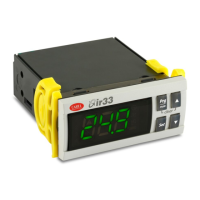50
ENG
ir33 universale +030220801 - rel. 2.1 - 21.06.2011
8. ALARMS
8.1 Types of alarms
There are two types of alarms available:
• high (temperature) E04 and low (temperature) E05;
• serious alarms, that is, all the others.
The data memory alarms E07/E08 always cause the control to shutdown.
“Alarm” mode (c0=5) can use one or more outputs to signal a low or
high temperature, probe disconnected or short-circuited alarm: see the
chapter on “Functions”. The e ect of the outputs on the alarms in special
operation depends on the “dependence” parameter: see the chapter on
“Functions”.
The controller also indicates alarms due to faults on the controller itself,
on the probes or in the “Auto-Tuning” procedure. An alarm can also be
activated via an external contact. The display shows “Exy” alternating with
the standard display. At the same time, an icon ashes (spanner, triangle
or clock) and the buzzer may be activated (see the table below). If more
than one error occurs, these are shown in sequence on the display.
On models featuring the clock, a maximum of 4 alarms are saved, in a FIFO
list (AL0,AL1,AL2,AL3). The last alarm saved can be read from parameter
AL0 (see the list of parameters).
Fig. 8.a
To mute the buzzer press .
8.2 Alarms with manual reset
• To cancel the signal of an alarm with manual reset, once the causes
have ceased, press
and for 5 seconds.
8.3 Display alarm queue
• Access the list of Parameters, as described in paragraph 3.3.3.
• Press / until reaching parameter “AL0” (last error saved).
• Press Set, this accesses a submenu where the and buttons
can be used to scroll between the year, month, day, hours, minutes and
type of alarm activated. If the controller is not tted with the RTC, only
the type is saved.
• From any of the parameters, pressing Set returns to the parent
parameter “ALx”.
Example:
‘y07’ -> ‘M06’ -> ‘d13’ -> ‘h17’ -> ‘m29’ -> ‘E03’
indicates that alarm ‘E03’(alarm from digital input) occurred on 13 June
2007 at 17:29.
8.4 Alarm parameters
The following parameters determine the behaviour of the outputs
when an alarm is active.
8.4.1 Status of the control outputs with probe alarm
(parameter c10)
This determines the action on the control outputs when there is a control
probe alarm E01, which may be one of the four responses envisaged.
When OFF is selected, the controller shuts down immediately and the
timers are ignored. When ON is selected, on the other hand, the “Delay
between activations of two di erent relay outputs” (parameter c6) is
observed. When alarm E01 is resolved, the controller restarts normally
and the alarm output, if set, terminates the signal (see mode 5). On the
other hand, both the signal on display and the buzzer remain active until
is pressed.
Par Description Def Min Max UoM
c10 Status of circuit 1 control outputs
with probe 1 alarm
0=All outputs OFF
1= All outputs ON
2=”Direct” outputs on, “reverse” o
3=“Reverse” outputs on, “direct” o
003 -
d10 Status of circuit 2 control outputs
with probe 2 alarm
see c10
003 -
Tab. 8.a
8.4.2 Alarm parameters and activation
P25 (P26) is used to determine the activation threshold for the low (high)
temperature alarm E05 (E04). The value set for P25 (P26) is continuously
compared against the value measured by probe B1. Parameter P28
represents the “alarm activation delay”, in minutes; the low temperature
alarm (E05) is activated only if the temperature remains below the value
of P25 for a time greater than P28. The alarm may relative or absolute,
depending on the value of parameter P29. In the former case (P29=0),
the value of P25 indicates the deviation from the set point and thus the
activation point for the low temperature alarm is: set point - P25. If the
set point changes, the activation point also changes automatically. In the
latter case (P29=1), the value of P25 indicates the low temperature alarm
threshold. The low temperature alarm active is signalled by the buzzer
and code E05 on the display. The same applies to the high temperature
alarm (E04), with P26 instead of P25.
Similar observations apply to the parameters corresponding to probe 2,
with the following relationships:
P25®P30; P26®P31; P27®P32; P28®P33; P29®P34; E04/E05®E15/E16.
Par Description Def Min Max UoM
P25
Low temperature alarm threshold on
probe 1
if P29=0, P25=0: threshold disabled
if P29=1, P25=-50: threshold disabled
-50
(-58)
-50(-58) P26 °C(°F)
P26 High temperature alarm threshold on
probe 1
if P29=0, P26=0: threshold disabled
if P29=1, P26=150: threshold disabled
150
(302)
P25 150
(302)
°C(°F)
P27 Alarm di erential on probe 1 2 (3,6) 0 (0) 50 (90) °C(°F)
P25 Low temperature alarm threshold on
probe 1
if P29=0, P25=0: threshold disabled
if P29=1, P25=-199: threshold disabled
-50
(-58)
-199
(-199)
P26 °C(°F)
P26 High temperature alarm threshold on
probe 1
if P29=0, P26=0: threshold disabled
if P29=1, P26=800: threshold disabled
150
(302)
P25 800
(800)
°C(°F)
P27 Alarm di erential on probe 1 2(3,6) 0(0) 99,9
(179)
°C(°F)
P28 Alarm delay time on probe 1(**) 120 0 250 min(s)
P29 Type of alarm threshold on probe 1
0=relative; 1=absolute
10 1 -

